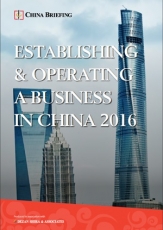China Market Watch: Forestry Sector Output Flourishes and China Railway Corp Releases Construction Plan and Budget for 2017
China looks to increase green energy consumption by 2020
China is aiming to build a clean, low carbon, safe, and modern energy system by 2020. Attention will be paid to the quality of the energy sector’s development by dealing with the country’s overcapacity problems and promoting green energy development. Efforts will also be made to increase market competition among energy and related sectors. This will mean a 15 percent reduction of energy use per unit of GDP by the year 2020, and that non-fossil fuel share will increase to more than 15 percent, with natural gas occupying 10 percent. Persistent air pollution has foregrounded this target, with 62 percent of 338 cities suffering bad air quality last week, according to the Ministry of Environmental Protection. In 2015, 64 percent of energy consumption in China derived from coal, the main source of breathable particulate matter (PM 2.5) which causes smog.
China’s booming forestry sector output
2016 saw China’s forest resource sector output increase to RMB 6.4 trillion, up 5.9 percent on the previous year, reading a 15 fold increase in the last 16 years. The country aims to see the sector’s output reach RMB 9 trillion by 2020. China has become the world’s largest producer, trader, and consumer of forest related products, with foreign trade standing at US$136 billion in 2016. Much of the sector’s growth has come from tourism; 1.2 billion trips to the country’s more than 9,000 forest based destinations were made last year, a 15 percent increase year on year. China has seen 21 new national forest parks opened in 2016, having state investment into forest parks reaching RMB 335 million.
![]() RELATED: Pre-Investment and Entry Strategy Advisory from Dezan Shira & Associates
RELATED: Pre-Investment and Entry Strategy Advisory from Dezan Shira & Associates
China’s outbound mobile payments surge
Alibaba has reported that outbound mobile payments last year increased by 730 percent year-on-year, driven by the number of people adept and confident in navigating online payments spending on outbound tourism and imported products. Transactions made via online wallets on the e-commerce platform could increase to around 90 percent of total business transactions this year. Alipay accounts for around 65 percent of China’s mobile payment market, which stands at RMB 12 trillion, while overseas transactions makes up around 10 percent. Tencent, which owns WeChat Pay, is quickly tapping into the online payment market, and accounts for 25 percent of the market share. There are now 762 million active users on its instant messaging app, WeChat.
China Railway Corp releases railway plan and budget
China’s state-run railway operator China Railway Corp (CRC) has been assigned a budget of RMB 800 billion for its plans to expand its rail network and increase scheduled trains in the coming year. CRC will add 2,100 km of track to the network, and 4,000 km of track will be electrified. As of last year, there was 124,000 km of railway, which features the longest high-speed rail network in the world, measuring over 20,000 km. One of the main aims of the plan is to improve railway quality in the country’s western regions, which have not benefited from as much investment. In addition to this, projects under the One Belt, One Road initiative will be constructed, including a China-Europe freight service, and other overseas railway projects. China aims to spend around RMB 3.5 trillion during the 13th Five Year Plan (2016-2020).
|
Asia Briefing Ltd. is a subsidiary of Dezan Shira & Associates. Dezan Shira is a specialist foreign direct investment practice, providing corporate establishment, business advisory, tax advisory and compliance, accounting, payroll, due diligence and financial review services to multinationals investing in China, Hong Kong, India, Vietnam, Singapore and the rest of ASEAN. For further information, please email china@dezshira.com or visit www.dezshira.com. Stay up to date with the latest business and investment trends in Asia by subscribing to our complimentary update service featuring news, commentary and regulatory insight.
|

 Establishing & Operating a Business in China 2016
Establishing & Operating a Business in China 2016
Establishing & Operating a Business in China 2016, produced in collaboration with the experts at Dezan Shira & Associates, explores the establishment procedures and related considerations of the Representative Office (RO), and two types of Limited Liability Companies: the Wholly Foreign-owned Enterprise (WFOE) and the Sino-foreign Joint Venture (JV). The guide also includes issues specific to Hong Kong and Singapore holding companies, and details how foreign investors can close a foreign-invested enterprise smoothly in China.
 An Introduction to Doing Business in China 2016
An Introduction to Doing Business in China 2016
Doing Business in China 2016 is designed to introduce the fundamentals of investing in China. Compiled by the professionals at Dezan Shira & Associates in June 2016, this comprehensive guide is ideal not only for businesses looking to enter the Chinese market, but also for companies who already have a presence here and want to keep up-to-date with the most recent and relevant policy changesSelling, Sourcing and E-commerce in China 2016
 Selling, Sourcing and E-Commerce in China 2016 (First Edition)
Selling, Sourcing and E-Commerce in China 2016 (First Edition)
This guide, produced in collaboration with the experts at Dezan Shira & Associates, provides a comprehensive analysis of all these aspects of commerce in China. It discusses how foreign companies can best go about sourcing products from China; how foreign retailers can set up operations on the ground to sell directly to the country’s massive consumer class; and finally details how foreign enterprises can access China’s lucrative yet ostensibly complex e-commerce market.
- Previous Article China-Mongolia Relations: Challenges and Opportunities
- Next Article Commerce Extérieur de la Chine en 2016 : Identification des Tendances et Opportunités

























